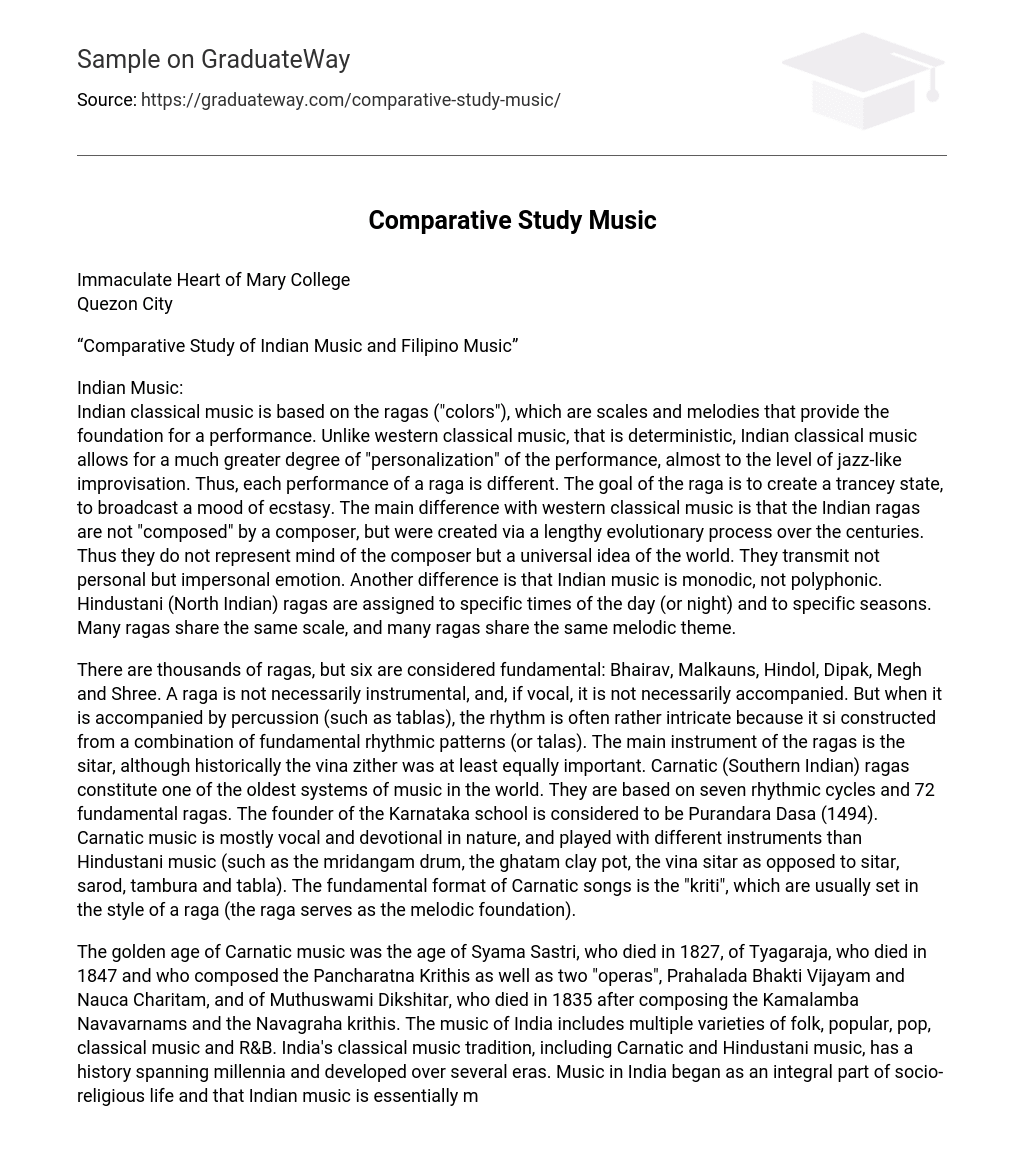Immaculate Heart of Mary College
Quezon City
“Comparative Study of Indian Music and Filipino Music”
Indian Music:
Indian classical music is based on the ragas (“colors”), which are scales and melodies that provide the foundation for a performance. Unlike western classical music, that is deterministic, Indian classical music allows for a much greater degree of “personalization” of the performance, almost to the level of jazz-like improvisation. Thus, each performance of a raga is different. The goal of the raga is to create a trancey state, to broadcast a mood of ecstasy. The main difference with western classical music is that the Indian ragas are not “composed” by a composer, but were created via a lengthy evolutionary process over the centuries. Thus they do not represent mind of the composer but a universal idea of the world. They transmit not personal but impersonal emotion. Another difference is that Indian music is monodic, not polyphonic. Hindustani (North Indian) ragas are assigned to specific times of the day (or night) and to specific seasons. Many ragas share the same scale, and many ragas share the same melodic theme.
There are thousands of ragas, but six are considered fundamental: Bhairav, Malkauns, Hindol, Dipak, Megh and Shree. A raga is not necessarily instrumental, and, if vocal, it is not necessarily accompanied. But when it is accompanied by percussion (such as tablas), the rhythm is often rather intricate because it si constructed from a combination of fundamental rhythmic patterns (or talas). The main instrument of the ragas is the sitar, although historically the vina zither was at least equally important. Carnatic (Southern Indian) ragas constitute one of the oldest systems of music in the world. They are based on seven rhythmic cycles and 72 fundamental ragas. The founder of the Karnataka school is considered to be Purandara Dasa (1494). Carnatic music is mostly vocal and devotional in nature, and played with different instruments than Hindustani music (such as the mridangam drum, the ghatam clay pot, the vina sitar as opposed to sitar, sarod, tambura and tabla). The fundamental format of Carnatic songs is the “kriti”, which are usually set in the style of a raga (the raga serves as the melodic foundation).
The golden age of Carnatic music was the age of Syama Sastri, who died in 1827, of Tyagaraja, who died in 1847 and who composed the Pancharatna Krithis as well as two “operas”, Prahalada Bhakti Vijayam and Nauca Charitam, and of Muthuswami Dikshitar, who died in 1835 after composing the Kamalamba Navavarnams and the Navagraha krithis. The music of India includes multiple varieties of folk, popular, pop, classical music and R&B. India’s classical music tradition, including Carnatic and Hindustani music, has a history spanning millennia and developed over several eras. Music in India began as an integral part of socio-religious life and that Indian music is essentially melodic: sounds follow one another expressing an emotional state in an aesthetic unity. Two main traditions of classical music are Carnatic music, found predominantly in the peninsular regions, and Hindustani music, found in the northern and central regions. Filipino Music:
Examples:
Awiting Pambata
Filipino children’s songs such as nursery rhymes in Tagalog
Tagalog Folk Songs
Tagalog Birthday Songs
Tagalog Christmas Songs
Mga Awiting Pamasko na kinakanta tuwing Pasko!
Tagalog Love Songs
Popular and Traditional Filipino Love Songs
Patriotic Songs of the Philippines
The Philippine National Anthem from the original Spanish poem, in English translation and in the official Tagalog / Filipino version currently sung in schools. Other patriotic songs popular during important political movements and events. Pop Songs
OPM stands for ‘Original Pilipino Music’
Filipino Songs Not in Tagalog
Filipino songs that are in other Philippine languages such as Cebuano, Winaray, Ilocano, Boholano, Chavacano and Kapampangan Funny Tagalog Songs
Music of the Philippines are performance arts composed in various genre and styles. The music of the Philippines is a mixture of other Asian, European,
Latin American, American, and indigenous influences. Traditional Music:
The Harana and Kundiman are lyrical songs popular in the Philippine Islands dating back to the Spanish period. Harana are traditional courtship songs in the Mexican-Spanish tradition based on the habanera rhythm while the Kundiman, which has pre-colonial origins from the Tagalog region, uses triple meter rhythm. Kundiman is also characterized by a minor key at the beginning and shifts to a major key in the second half. Its lyrics depict a romantic theme, usually portraying love, passion, or sadness. In the 1920s Harana and Kundiman became more mainstream musical styles led by performers such as Atang de la Rama, Jovita Fuentes, Conching Rosal, Sylvia La Torre and Ruben Tagalog.
The Tinikling is a Philippine dance which involves two individual performers hitting bamboo poles, using them to beat, tap, and slide on the ground, and fartand against each other in co-ordination with one or more dancers who steps over, and in between poles The Cariñosa (meaning loving or affectionate one), is a Philippine national dance from the María Clara suite of Philippine folk dances, where the fan, and handkerchief plays an instrument role as it places the couple in romance scenario. The dance is similar to the Jarabe Tapatío. The Cariñosa is accompanied with Hispanic music, and language. It is also related to Kuracha, Amenudo and Kuradang in the Visayas and Mindanao Area. The Rondalla is performed on ensembles comprising mandolin instruments of various sizes called banduria composed on the Iberian tradition. Other instruments including guitars, is also performed.It is original to Spain. Indian and Filipino Music:
In every country we have our own tradition and styles in music. But both have different kind of songs like pop, rock, folk, etc. On our music now, it already has a mixture of other country’s music. In Indian music, some are influenced by the new kind of songs but they are still supporting their own kind of Music. Sometimes Indian music is religious, Philippine music is more on nature.
Source: google, book





